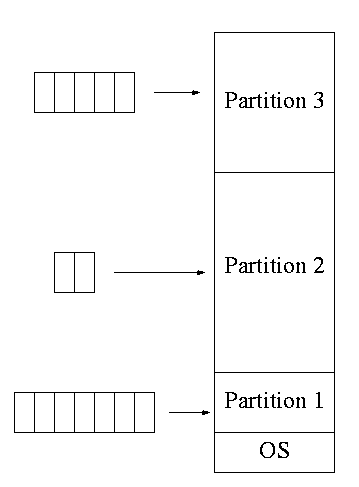Operating Systems
Start Lecture #17
Remark: Lab 3 (banker) assigned.
It is due in 2 weeks.
Midterm Exam Answers Reviewed:
Running Multiple Programs Without a Memory Abstraction
This can be done via swapping if you have only one program loaded
at a time.
A more general version of swapping is discussed below.
One can also support a limited form of multiprogramming, similar to
MFT (which is described next).
In this limited version, the loader relocates all relative
addresses, thus permitting multiple processes to coexist in physical
memory the way your linker permitted multiple modules in a single
process to coexist.

**Multiprogramming with Fixed Partitions
Two goals of multiprogramming are to improve CPU utilization, by
overlapping CPU and I/O, and to permit short jobs to finish quickly.
- This scheme was used by IBM for system 360 OS/MFT
(multiprogramming with a fixed number of tasks).
- An alternative would have a single input
list
instead
of one queue for each partition.
- With this alternative, if there are no big jobs, one can
use the big partition for little jobs.
- The single list is not a queue since would want to remove
the first job for each partition.
- I don't think IBM did this.
- You can think of the input lists(s) as the ready list(s)
with a scheduling policy of FCFS in each partition.
- Each partition was monoprogrammed, the
multiprogramming occurred
across partitions.
- The partition boundaries are not movable
(must reboot to move a job).
- So the partitions are of fixed size.
- MFT can have large internal fragmentation,
i.e., wasted space inside a region of memory assigned
to a process.
- Each process has a single
segment
(i.e., the virtual
address space is contiguous).
We will discuss segments later.
- The physical address space is also contiguous (i.e., the program
is stored as one piece).
- No sharing of memory between process.
- No dynamic address translation.
- OS/MFT is an example of address translation during load time.
- The system must
establish addressability
.
- That is, the system must set a register to the location at
which the process was loaded (the bottom of the partition).
Actually this is done with a user-mode instruction so could
be called execution time, but it is only done once at the
very beginning.
- This register (often called a base register by ibm) is
part of the programmer visible register set.
Soon we will meet base/limit registers, which, although
related to the IBM base register above, have the important
difference of being outside the programmer's control or
view.
- Also called relocation.
- In addition, since the linker/assembler
allow the use of addresses as data, the loader itself
relocates these at load time.
- Storage keys are adequate for protection (the IBM method).
- An alternative protection method is base/limit registers,
which are discussed below.
- An advantage of the base/limit scheme is that it is easier to
move a job.
- But MFT didn't move jobs so this disadvantage of storage keys
is moot.
3.2 A Memory Abstraction: Address Spaces
3.2.1 The Notion of an Address Space
Just as the process concept creates a kind of abstract CPU to run
programs, the address space creates a kind of abstract memory for
programs to live in.
This does for processes, what you so kindly did for modules in the
linker lab: permit each to believe it has its own memory starting at
address zero.
Base and Limit Registers
Base and limit registers are additional hardware, invisible to the
programmer, that supports multiprogramming by automatically adding
the base address (i.e., the value in the base register) to every
relative address when that address is accessed at run time.
In addition the relative address is compared against the value in
the limit register and if larger, the processes aborted since it has
exceeded its memory bound.
Compare this to your error checking in the linker lab.
The base and limit register are set by the OS when the job starts.
3.2.2 Swapping
Moving an entire processes between disk and memory is called
swapping.
